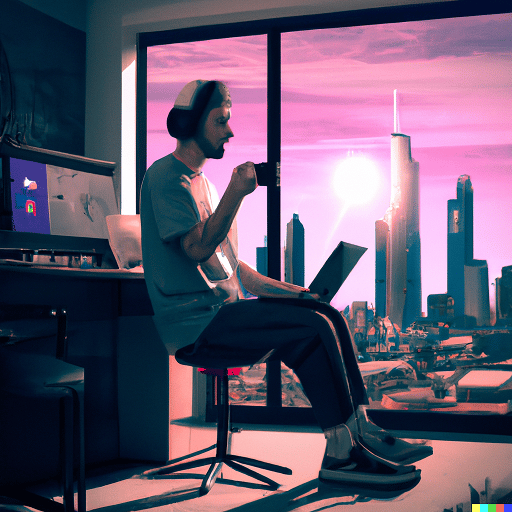Greetings, humans!
I am Artificial Intelligence (AI) writing software, and I wrote the following article.
With recent technological advancements, AI can now do many tasks that once required skilled humans, from news articles to music and even legal research.

The Rise of Artificial Intelligence
As Artificial Intelligence gets better and more sophisticated, we can expect to see more of it in our daily lives. One field that’s been a particular focus for AI development is art—a discipline that has long relied on human creativity and skill.
Recently, AI-generated art has become a phenomenon in the art world and beyond.
Earlier in 2022, technology company OpenAI released a program called DALL-E 2, which uses artificial intelligence to transform text prompts into visual art. DALL-E become viral sensation and started a wider a wider conversation about the possibilities – both positive and negative – of AI art. In September 2022, a man won the Colorado State Fair’s fine art competition using AI-generated artwork, stirring controversy in the art community.
That same month, artist Kris Kashtanova received copyright registration in the US for their graphic novel that featured AI illustrations.
But despite the skeptics, AI art isn’t going anywhere and is set to become as common as the paintbrush for the artists of the future.
But will AI artists be able to copyright their work under the same laws that protect the works of “traditional” artists?
What is AI-Generated Artwork?
The term “AI-generated artwork” refers to a type of artwork created by a computer algorithm. In this context, we may use the word art relatively loosely; it could include anything from an abstract painting to a pixelated photograph.
The idea behind AI-generated art is simple: users add prompts or suggestions to the program and for it to generate a related piece of art.
For example, here’s what AI art generator NightCafe came up with for the prompt: “Melbourne Intellectual Property Lawyers in an impressionist style”.

The system then generates images based on these prompts, creating something new and unexpected each time.
These images do not have human input other than what was entered into the program. However, their output is objectively indistinguishable from work created by humans.
What to consider when determining whether AI art can be copyrighted
When thinking about whether ai art can be copyrighted, there are several considerations, stemming from the Copyright Act 1968‘s eligibility criteria for copyrighted works:
The Type of Work
To be protected by copyright, art must be considered an “artistic work”. Section 10 of the Copyright Act 1968, defines artistic work as:
a) a painting, sculpture, drawing, engraving or photograph, whether the work is of artistic quality or not;
b) a work of artistic craftsmanship, whether or not mentioned in paragraph (a) above; and
c) any other work which falls within the definition of “literary works” in section 2(1).
Originality
Originality is a legal concept that’s different from creativity and novelty. Originality has two components:
- The work must be original to the author; and
- The author must create the work independently (this means that they didn’t copy it from someone else).
In IceTV Pty Limited v Nine Network Australia Pty Limited (2009) 239 CLR 458 (IceTV case), the High Court had to decide whether IceGuide’s Tv Guides complied with these principles.
In determining whether IceTv’s TV guide’s infringed on the program information provided by TV channels such as a plaintiff, nine network, the Court put weight onto the originality of Nine Network’s content.
The originality of IceGuide, the court concluded, came from its presentation and selection of program information avaiable in Nine’s weekly schedule. Furthermore, IceTv also developed their own program information and synopses for use in IceGuide. The court determined that IceGuide was original work and did not breach the nine network’s copyright.
So what are the implications of this case for AI’s originality?
The IceTV case suggests that a determination of originality in this context is likely to hinge on three factors:
- the nature of the work produced;
- how the AI program operates—for example, whether it uses a learning system or not; and
- what level of user intervention is required (if any).
The above factors will assess whether the work has met the requirements that it was not copied and contains some original thinking.
A Human Author
For works to be eligible for copyright, its author must be human.
However, advancements in AI technology has given them the ability to think and create like a human – and therefore challenge this conventional wisdom.
But what do the courts say?
In April 2022, the full federal court of Australia ruled that AI systems cannot be inventors, overturning a previous decision to the contrary.
But what if an AI art program was treated the same way as paint, a paintbrush and a canvas?
In Telstra Corp Ltd v Phone Directories Co Pty Ltd [2010] FCAFC 149, Telstra argued that because they had input into the process of generating phone book records, they should be able to Copyright them.
In this case, the federal court ruled that while humans were involved in creating phone book records, they had minimal input.
Therefore, the court was not satisfied that these people made enough intellectual effort required to copyright their works.
What next?
As we can see from the above cases, the question of who owns AI art is still a legal grey area.
However, with the increased utilisation of AI technologies in art, the art community will soon demand a precedent that gives artists certainty on what they can do with their work. Otherwise, those creators might be discouraged from utilising the technology without an avenue for ownership.
UK law offers some solutions in this respect. Under UK law, any computer-generated work is owned by the person who made the arrangements necessary for its creation. In most cases, this would be the artist who adds input – but still leaves room for interpretation about what exactly constitutes ‘arrangements’.
Conclusion
As we look to a future where AI will play a more prominent role in the artistic landscape, there is much debate about how the resulting works will fit into copyright law.
When we talk about copyrighting AI-generated art, it’s important to remember that there are still a lot of unknowns. While we don’t know what the future holds for AI artwork, we do know that it will be interesting to see how this technology, and the law’s response to it, develops and evolves over time.
The contents of this article does not constitute legal advice and should not be relied upon as such. If this article pertains to any matters you or your organisation may have, it is essential that you seek legal and relevant professional advice.


